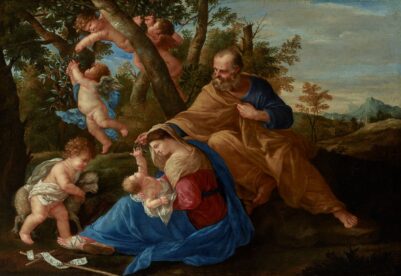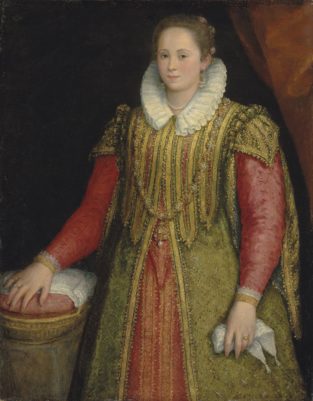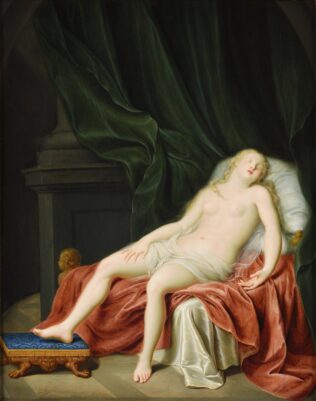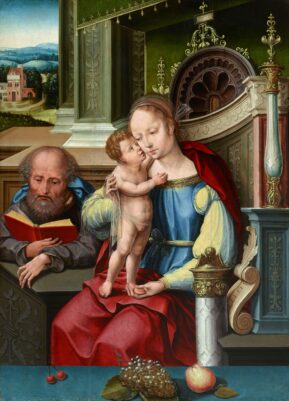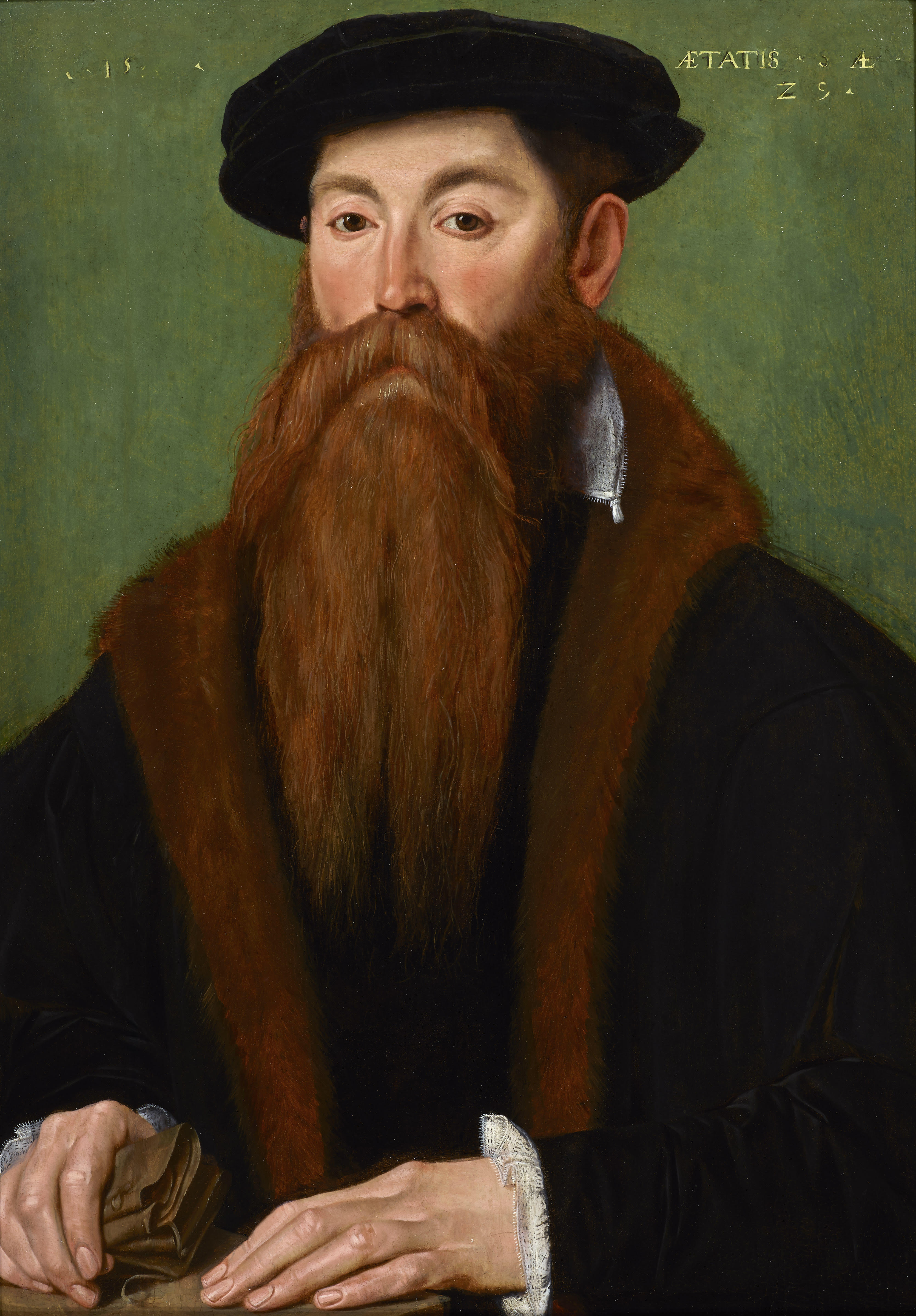
Master of the 1540s
Portrait of a gentleman
Provenance:
Art market, London (1925).
Anonymous sale, Sotheby’s New York, 20 January 1983, lot 59, when acquired by a foundation; by whom anonymously sold (‘The Property of a Foundation’), Sotheby’s, London, 7 July 2011, lot 135, when acquired by the present owner.
Bibliography:
M. J. Friedländer, Die Altniederländische Malerei, vol. XIII, Berlin 1936, p. 163, no. 256.
M. J. Friedländer, Early Netherlandish Painting, vol. XIII, Leiden 1975, p. 94, no. 256 (illustrated pl. 126).
Catalogue Entry

Fig. 1. Master of the 1540s, Portrait of a gentleman, details.
The half-bust figure of a bearded man with a dark cap directs his gaze at the viewer with inscrutable severity. Captured in three-quarter view, he wears a dark garment with white cuffs and a white collar; the dark brown colour and the softness of its fur trim echo those of the man’s long beard and moustache. The sitter holds a pair of gloves in his right hand, while he rests his other hand on the edge of a wooden table. His figure stands out before a monochromatic green background. An inscription in yellow paint appears in the upper section of the panel. The digits ‘15’ are visible to the right of the man’s head, while the inscription ‘AETATIS SVAE’, which has partially faded, appears to its left (Fig. 1).

Fig. 2. Photograph of the Portrait of a gentleman published in Max J. Friedländer’s Early Netherlandish Painting, plate 256.
The Portrait of a gentleman appears in volume XIII of Max J. Friedländer’s Die Altniederländische Malerei, as Bildnis eines 29-jährigen mannes mit langem bart, or Portrait of a twenty-nine year old man with a long beard.1 The painting is also included in the volume’s revised and translated edition of 1972 as Portrait of a Gentleman aged 29, accompanied by a black and white photograph dating to 1925 (Fig. 2).2 In his publications, Friedländer attributed the painting to the so-called ‘Master of the 1540s,’ an anonymous painter of approximately thirty portraits, many of which had been previously ascribed to Pieter Pourbus (c. 1523-1584). Friedländer derived the unidentified artist’s name from the period when the works were executed, spanning from about 1541 to 1551. His only two identified portraits, that of Gillebert van Schoonbeke, patron of the Antwerp hospital, and his wife Elisabeth Heyndericx (1544, KMSKA – Royal Museum of Fine Arts Antwerp, Fig. 3 and 4,) suggest the artist was active in the city. Possibly a follower of Joos van Cleve (1485-1540), the Master is believed to have contributed to filling the void created in the field of portraiture by the artist’s death in 1540. According to Friedländer, the Master of the 1540s seems to have lacked van Cleve’s artistic range or connections at court, working primarily for the bourgeoisie and the merchant class. This is suggested by his “neat and solid craftsmanship,” which, at the time, could be cultivated only when working for a small, refined clientele.3 Portraits by the Master of the 1540s are today in some of the most important museums worldwide, including the Art Institute of Chicago, the Fogg Art Museum and the Art Gallery of New South Wales.

Fig. 4. Master of the 1540s, Portrait of Elisabeth Heyndericx, oil on panel, 59 x 44 cm, 1544, Antwerp Museum of Fine Arts, Antwerp.

Fig. 3. Master of the 1540s, Portrait of Gillebert van Schoonbeke, oil on panel, 1544, Antwerp Museum of Fine Arts, Antwerp.
Friedländer assembled the Master of the 1540s’ corpus of works primarily on stylistic grounds. Several of the distinctive features of this portraitist seem to characterise the present work. The way the Portrait of a gentleman is inscribed can be regarded as one of the artist’s trademarks. Indications of the year of execution and the sitter’s age are located near the top, at the level of head-covering, in proportioned Roman capitals and angular Arabic numerals, as they appear, for example, in the Portrait of a forty-nine year old man (Fig. 5, Galleria Sabauda, Turin). If the two paintings are compared, one can assume the present work’s year of execution to have originally appeared at the top left and to have faded later in time. The small trait visible on the far left seems to be the finishing part of what was originally an ‘A’ – initial for ‘anno’, or year – while ‘15’ are probably the first two digits of the painting’s incomplete date. On the right, an almost completely preserved inscription – still fully visible in the photograph included in Friedländer’s 1972 volume – suggests the age of the sitter, who was 29 years old when posing for his portrait. The half-high full stops separating words and numbers are of a curious tricorn shape, a recurring element in the Master’s oeuvre, defined by Friedländer as “a tiny bird in flight.”4

Fig 5a. Master of the 1540s, Portrait of a forty-nine year old man, oil on panel, 63 x 49 cm., 1542, Galleria Sabauda, Turin.

Fig. 5b. Details of Fig. 5a.
As in many portraits by the Master of the 1540s, the sitter is seen frontally, his body slightly averted, against a neutral background. His head is placed close to the top edge of the panel, as can be seen in several other portraits by the artist, such as the aforementioned portraits of Gillis van Schoonbeke and his wife, and the Turin portrait. The monochrome backdrop is of intermediate brightness, emphasising the sitters’ silhouette and allowing the flesh parts to stand out. Despite the man’s severe expression, a sense of liveliness is suggested by the naturalistic reddening of his cheeks and nose. His gorgeous beard and the fur trimming of his garment appear as almost palpable, similarly rendered through thin brushstrokes of steadfast quality. The velvety texture of the sitter’s eyebrows is a noteworthy characteristic of the artist, as are the long, conical fingers with oval nails of the man’s hands, which are here masterfully painted.

Fig. 6. Pieter Pourbus, Portrait of a man holding his gloves, oil on panel, 39.5 x 30 cm., 1544, The National Gallery, Oslo.

Fig. 8. The Master of the 1540s, Portrait of a man, oil on panel, 64 x 47 cm., c. 1540-1550, Private Collection.

Fig. 7. The Master of the 1540s, Portrait of a man, oil on panel, 62.8 x 49 cm., 1547, Private collection.
Although stylistic and formal similarities with the present work can be found in the oeuvre of coeval painters, primarily with Pieter Pourbus (Fig. 6), Friedländer’s attribution to the Master of the 1540s has never been questioned by scholarship so far.
As most sitters painted by the Master of the 1540s, the man in the present work remains unidentified. The lack of armorial bearings or insignia does not give any hint on his calling, office or title, suggesting that he probably belonged to the wealthy merchant class rather than to the aristocracy. This seems to be further confirmed by the man’s refined yet restrained outfit, as well as by his gesture of holding a pair of gloves, a standard trademark of a gentleman in early Netherlandish portraiture, also appearing in other similar portraits by the artist (Fig. 7 and 8).5 This gesture, along with the sitter’s severe attitude and the image’s overall clarity epitomise how the artist conformed with the conventions of traditional Netherlandish portraiture, which aimed at stressing the decency, respectability and moral purity of the sitter.
1 M. J. Friedländer, Die Altniederländische Malerei, vol. XIII, (Berlin 1936), p. 163, no. 256. 2 M. J. Friedländer, Early Netherlandish Painting, vol. XIII, (Leiden 1975), p. 94, no. 256 (illustrated pl. 126). 3 For an overview on the Master of the 1540s, see Friedländer, Early Netherlandish Painting, 46-47. 4 Ibid., 47. 5 John Oliver Hand and Martha Wolff, Early Netherlandish Painting, (Washington: National Gallery of Art, 1986), 61.
Condition:
Dendrochronological analysis has revealed the panel to be constructed from three oak boards. It has been thinned at some stage, probably as a result of distortion or to better resolve the joins. The image is very tight and, no doubt, has been reduced, certainly in its width, at some point.
The painting has recently been restored. The paint surface is relatively clean, and the varnish is discoloured. There are two restored vertical splits which run the height of the panel, one 7 cm. from the left margin and the other down the central axis. Both have associated visible retouching, and the latter also has a few tiny scattered losses, as well as a larger patch of restoration to the right of the sitter’s nose. There is an area of visible retouching in the background just left of the sitter’s face approx. 9 x 5 cm. There is evidence of past flaking with associated tiny spots of paint loss in the 10 cm. below the upper margin, as well as a larger loss approx. 1 x 2 cm. The paint surface now appears stable. Inspection under ultraviolet light reveals a very thick varnish which fluoresces opaque, underneath which some of the aforementioned retouching confirmed, but it is difficult to discern anything else, and the painting appears in overall fairly good condition.
